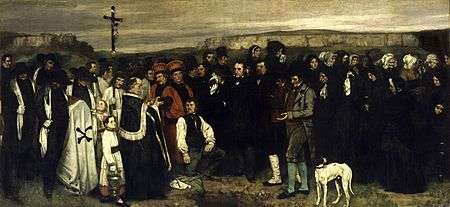Smarthistory
| Non-profit organization | |
| Headquarters | Brooklyn, New York |
| Products | Smarthistory.org, podcasts, SmarthistoryTravel apps |
| Website | www.smarthistory.org |
Smarthistory is a free multimedia web-book for art history created by Beth Harris and Steven Zucker which are also main editors. Smarthistory is the official partner to Khan Academy for art history.
Started in 2005 as a blog of audio guides for use in the Metropolitan Museum of Art[1] and the Museum of Modern Art in New York City,[2] Smarthistory has grown to include video, annotated slide shows, images, mobile apps, social media and written content created by the original creators as well as contributing art historians. Smarthistory is a not-for-profit corporation.[3] According to the Smarthistory about page:
We are interested in delivering the narratives of art history using the read-write web's interactivity and capacity for authoring and remixing. Publishers are adding multimedia to their textbooks, but unfortunately they are doing so in proprietary, password-protected adjunct websites. These are weak because they maintain an old model of closed and protected content, eliminating Web 2.0 possibilities for the open collaboration and open communities that our students now use and expect.[4]
Smarthistory won a Webby Award for Education in 2009.[5] The Samuel H. Kress Foundation gave them a $25,000 grant for development in 2008 and a $38,000 partnership development grant with the Portland Art Museum in 2009.[6]
 | |
|
|
In an article in the Brooklyn New York Daily News, staff writer Elizabeth Lazarowitz quotes Steven Zucker, "Art can be really intimidating for people", said Zucker. "If we can make art feel exciting and interesting and very much relevant to a historical moment...art can have real meaning." Unlike reading about art in a book, "the idea of the audio was to keep a student's eyes on the image", he explained. "It helped students to learn the material a lot better."[7]
In a collaborative article by Beth Harris and Steven Zucker, the founders explain the value of the resource for teachers, students, and informal learners: "Smarthistory is helping teachers who are not specialists in art history find strategies to make the subject accessible and meaningful to students who might otherwise not have cultural resources available to them. And for college students, the site is fast becoming an attractive alternative to the commercial textbook whose short life cycle and $100+ price tag has increasingly become a barrier."[8]
In a Chronicle for Higher Education article, Beth Harris is quoted on the ambitions and goals of Smarthistory: "We really just wanted to re-embed the objects in our world", says Harris, who is the founder and executive editor of Smarthistory as well as the director of digital learning at a New York City museum. "We thought that that would make them more relevant and more engaging for students."[9]
References
- ↑ "Podcasts for the Metropolitan Museum of Art"
- ↑ "E-Learning: Smarthistory.org"
- ↑ www.smarthistory.khanacademy.org About. Retrieved 2013-10-12.
- ↑ "Smarthistory About Page"
- ↑ "Webby Award Winners 2009"
- ↑ "About the partnership with Smarthistory"
- ↑ "Brooklyn-based art historians launch website with videos of masterpieces" New York Daily News, 2/25/2011
- ↑ "Conversation is Key: A Short History of Smarthistory.org"
- ↑ "'Smarthistory' rethinks the art history textbook online"
External links
- Official website
- "'Smarthistory' rethinks the art history textbook online", The Chronicle of Higher Education, 11/23/2010
- PC Magazine: Top 100 Websites of 2009, 7/27/2009
- "Daily Dose Pick: Smarthistory" Flavorpill, 7/09/2009
- "Smarthistory and Portland Art Museum", May 2009
- "Brooklyn-based art historians launch website with videos of masterpieces" New York Daily News, 2/25/2011